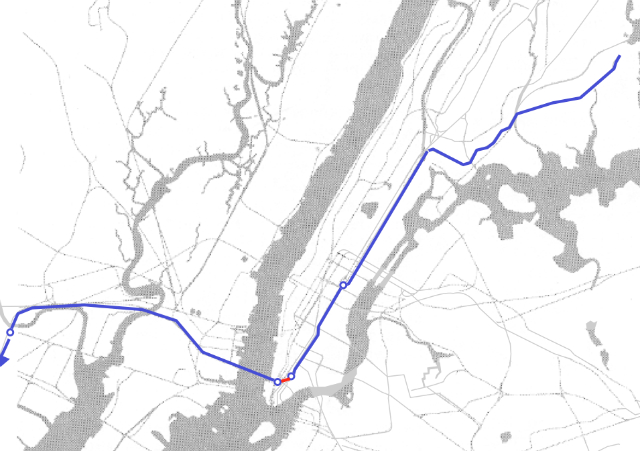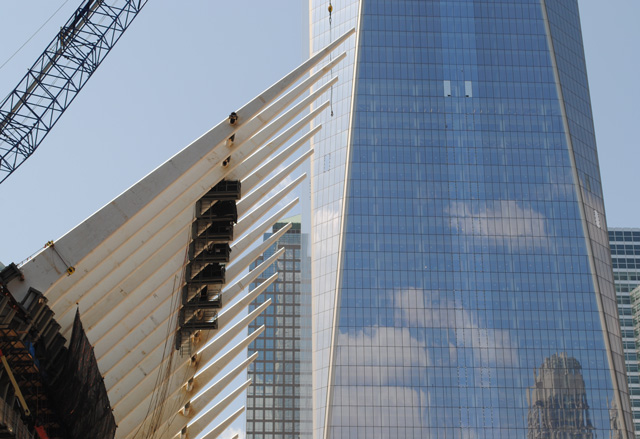The redevelopment of the World Trade Center continues 13 years after the terrorist attacks of September 11, 2001. The site’s $4 billion PATH terminal will be finished by the end of next year, eight years behind schedule and around $2 billion over budget. The most expensive train station on earth, former Mayor Michael Bloomberg’s spokesman called it “a national symbol of government waste.”
When the station does open, lower Manhattan will have a new monumental structure, but one of questionable utility. It will do little to improve transit capacity and nothing to improve regional connectivity.
As planning for the redevelopment of lower Manhattan proceeded in the politically charged years following 9/11, a group of transit planners put forward an ingenious alternative: rather than terminate PATH trains at the World Trade Center, the Port Authority and MTA could work together to extend the tracks another 3,000 feet to the east and connect with the 6 train at Brooklyn Bridge-City Hall.

The PATH and 6 trains in blue, and the proposed connection in red. Diagram by the Regional Rail Working Group.
The benefits of this connection, called PATH-Lex by its boosters, would have been enormous: a one-seat ride from Newark and Jersey City through lower Manhattan and up the East Side and then on to the Bronx. This could have essentially been the first direct cross-Hudson rail link with Grand Central Station, and would have involved minimal new tunneling. But the idea was dismissed before it could gather momentum.
Senior leadership at the Port Authority shut down the idea after meeting with advocates and Congressman Jerrold Nadler at the end of 2003. George Haikalis – a retired transit and regional planner and perpetual thorn in the side of New York area transit agencies, who’s tried (unsuccessfully) for decades to bring global best practices to the region – was among the advocates present.
“New York City Transit was reasonably interested in that, and was willing to listen to us,” Haikalis told YIMBY. “The Port Authority was absolutely hostile to the idea.”
The Port Authority did explore the proposal, hiring a consultant that concluded the idea was not feasible. “They hired Parsons Brinckerhoff to show how you couldn’t do it,” Haikalis said.
Trains would have to climb too steep a grade, the consultants concluded at a meeting on October 3, 2003. There wasn’t enough room to pass under the A/C line and then over the 2/3 trains.
Weaving a new tunnel through lower Manhattan’s crowded underground mix of utilities, building foundations and subway tunnels would be difficult, but it was possible, Haikalis and other transit advocates believed.
“You could squeeze it in,” Haikalis said. “The connection was difficult to make but it could be done. It was clear the Port Authority was not going to allow that and they had the resources to prevent anyone from doing it.”
In a letter to the Port Authority dated August 4, 2004, Albert Papp, then president of the New Jersey Association of Railroad Passengers, flatly refuted the Port Authority’s findings and conclusions, saying that their PATH-Lex proposal was misunderstood and misrepresented. The strict adherence to standards that the Port Authority used to deem the project unfeasible, Papp wrote, “virtually precludes not only the PATH-Lex Connection, but also most future subway or regional rail construction in lower Manhattan, and, in fact, much of the rest of the borough as well.”
The climbs required, Haikalis wrote in a letter to the MTA and Port Authority, would have been equal to or less than those the 7 train makes hundreds of times each day crossing the East River.
John West, a consultant at BFJ Planning and a member of the planning committee at the Municipal Arts Society, was also among those pushing for the project. “We made every effort to explain it,” West said. “There were issues of the slope of tracks, radii of curves, clearances between underground structures, and we were able to answer them all. In the end I think the real problems were perceptual and institutional.”
For decades, there has been a strong institutional and political reluctance to integrate the region’s balkanized transit systems. “There have been endless attempts to create a regional rail system,” said Haikalis. “These institutions remain as their own empires.”
The giant animalistic structure now rising at the World Trade Center has the potential to be very beautiful once completed, but it has no real utility as a piece of transit infrastructure. “It’s an ancillary structure,” Haikalis said, noting that the Calatrava structure isn’t even over the station platforms.
It will also do little to smooth transfers to the MTA’s Fulton Center to the east, as passengers will still have to pay a double fare and make a long trek – more pleasant in experience but similar in distance to the transfer at 14th Street between the stations beneath Sixth and Seventh Avenues – beneath two subway lines to get from the PATH station to the heavily trafficked Lexington Avenue express trains beneath Broadway.
Though the PATH station will do little to improve commutes, one can imagine it appealing to tourists and visitors, few of whom will be boarding trains to Jersey City, Harrison or Newark. The main PATH concourse will have “225,000 square feet of exciting, multi-level retail and restaurant space,” according to the Port Authority’s website – a shopping mall masquerading as a transit project.
“It’s painful that the powers that be like Pataki and Bloomberg couldn’t rise to the occasion to do something more imaginative,” said Haikalis.
The opportunity for the PATH-Lex connection has likely been closed for now. A connection may be possible in the future, but it would mean digging underneath the new PATH hub or bringing the $4 billion structure down.
“I am sorry PATH-Lex did not happen,” said John West. “It would have been good for the traveling public and because it would have set an example for through running NJ Transit and LIRR service at Penn Station.”
Talk about this topic on the YIMBY Forums
For any questions, comments or feedback, email [email protected]
Subscribe to YIMBY’s daily e-mail
Follow YIMBYgram for real-time photo updates
Like YIMBY on Facebook
Follow YIMBY’s Twitter for the latest in YIMBYnews






